Four months after New Horizons' historic flyby, mission scientists are amazed by unexpected discoveries — and by how some preconceptions about Pluto were flat-out wrong.
Results from New Horizons' July 14th flyby of Pluto and its moons continue to trickle back to Earth (about 80% of the data remain unseen). But after four months of anticipation, the mission's scientists finally addressed an audience of their peers to reveal what's been learned so far. The setting was the American Astronomical Society's Division for Planetary Sciences annual meeting, held this week in National Harbor, Maryland.
Although several dozen presentations offered glimpses of all the mission results, the spotlight shone most brightly on Pluto's surface, its atmosphere, and its quartet of small moons. (Results about Charon, an amazing little world in its own right, will likely take center stage next month at a meeting of American Geophysical Union.)
Massive Ice Volcanoes?
The spacecraft's images have already shown that Pluto has an unexpectedly dynamic geology, with towering ice mountains, fresh plains of nitrogen ice that have slowly oozed like glaciers, and a deeply fractured crust. Now you can add "giant ice volcanoes" to that list.
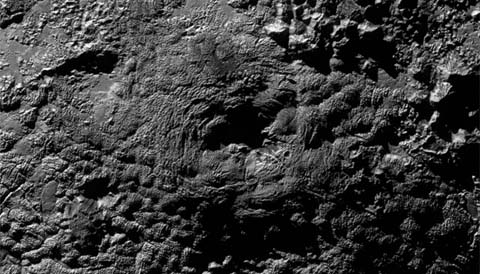
NASA / JHU-APL / SWRI
During a press briefing yesterday, Oliver White (NASA Ames Research Center) described two broad, tall mountains that are at least 150 km across and topped with depressions at their summits. They're dead ringers for the kind of broad shield volcanoes found on Earth (think "Mauna Kea") and other inner planets ("Olympus Mons") — and very unlike anything ever seen on dozens of icy moons in the outer solar system. "Whatever they are, they're definitely weird," admits White, "and volcanoes is the least weird explanation at the moment."
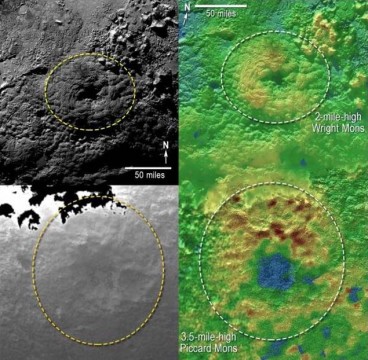
NASA / JHU-APL / SWRI
The two mounds aren't immediately obvious in any given image, but they're obvious in the 3-D topographic maps created by viewing the surface from multiple angles. The taller one, informally named Piccard Mons, is 5 km high, and Wright Mons is 3 km high. The "lava" in this case would have been slushy mixtures of water and other icy compounds that became liquefied deep down and gushed out onto the surface. If these really are cryovolcanoes, their summit depressions mark areas of collapse once the source feeding them shut down. Strange, hummocky textures on their flanks might represent individual flows.
Add "Piccard" and "Wright" to the growing evidence that Pluto's interior remained warm — and likely still is warm — for more than 4 billion years. Ordinarily, objects of this size should have frozen solid long ago. Interior heat could have been stoked by tidal interactions with another body, as occurs on Io. But Pluto and its big moon Charon are locked in a spin-orbit coupling that rules out tidal energy. The only other plausible heat source would be the long-term decay of radioactive isotopes in Pluto's rocky core.
Pluto's Surprising Atmosphere
Ever since the 1988 discovery that Pluto has a thin atmosphere, researchers have pondered how it's managed to stick around. The surface is so cold — especially when Pluto is farthest from the Sun in its strongly elliptical orbit — that what little gas exists should freeze and fall to the icy surface. Calculations also show that ultraviolet part of sunlight, though weak, should be energizing atoms of gas to escape velocity. Some researchers had even speculated that Pluto's atmosphere extended all the way to Charon.
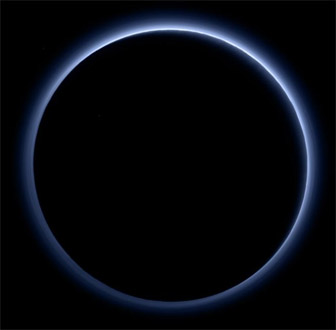
NASA / JHU-APL / SWRI
Nope, that's not the case at all! As Leslie Young (Southwest Research Institute) explained yesterday, Pluto's atmosphere is much colder and more compact than anyone expected. That's the outcome of two sets of occultations, when New Horizons was hidden from the Sun and from Earth, that yielded profiles of the atmosphere's density and temperature with altitude.
Decades of ground-based observations, especially stellar occultations (as recently as June 29th), had suggested that the exobase (essentially the level at which atoms can fly away freely into space) was roughly 7,500 km (5,000 miles) up — seven or eight times Pluto's radius. But instead, Young reports, it's more like 2½ times. So the atmosphere is far colder and more compact than expected. "From an Earth-based perspective," admits principal investigator Alan Stern, "we got it all wrong."
What's key in this finding is that Pluto's atmosphere is there to stay — the atmospheric loss must be thousands of times less rapid than predicted. "We expected escape rate rapid enough to lose the equivalent of a half-mile-thick layer of surface ice over 4½ billion years," Young explains, "but now it's more like half a foot."
Moreover, the atmosphere's structure is defying expectations as well. The New Horizons team had expected to find a well-defined troposphere just above the surface, mimicking the 8-km-high layer found around Neptune's moon Triton (long thought to be a geologic sibling of Pluto). But the occultations showed a barely-there troposphere in some spots and none at all in others.
Cratering Tells a Story
The spacecraft's good views of the daylit side of Pluto reveal more than 1,000 craters in the icy surface, but they're not evenly distributed. According to to Kelsi Singer (Southwest Research Institute), Pluto's northern and mid-latitudes, along with the enigmatic dark region that's been dubbed Cthulhu, appear to be oldest — surfaces largely unchanged for perhaps 4 billion years.
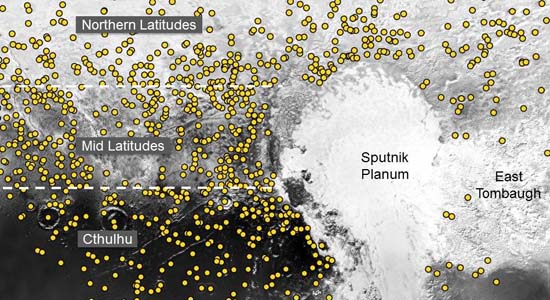
NASA / JHU-APL / SWRI
By contrast, the eastern half of the big, heart-shaped plain known as Tombaugh Regio might be just 1 billion years old. And billiard-ball-smooth Sputnik Planum, completely craterless, can't be any older than about 10 million years — and could be much younger.
Crater counters are also using the New Horizons images to learn about the bodies in the Kuiper Belt that created all those icy divots. Most of the impactors were no bigger than a few km across, but that's smaller than ground-based telescopes can detect. Observers using the Hubble Space Telescope have detected two ultrabrief dimmings of background stars that they attribute to Kuiper Belt objects only about 1 km across. Those HST finds imply that the Kuiper Belt teems with abundant small planetesimals — the building blocks from which larger bodies assembled.
But the cratered faces of Pluto and Charon don't bear out that scenario. Instead, notes Alex Parker (Southwest Research Institute), the distribution of sizes in the Kuiper Belt must be more akin to what's found in the asteroid belt. In that case, the Kuiper Belt's basic building blocks were tens of kilometers in size. This is the likely diameter, he adds, of the spacecraft's next target — 2014 MU69. So if New Horizons gets a green light from NASA managers to reconnoiter that body, planetary scientists might get a glimpse of a truly primordial object when it flies past in early 2019.
Chaotically Whirling Moons
Dynamicists assume that Pluto's five moons — beefy Charon and much smaller Nix, Hydra, Kerberos, and Styx — all resulted from a titanic impact on Pluto, early in solar system history, that yanked its spin axis over to one side and created a ring of debris in its reoriented equatorial plane. July's hi-and-bye flyby didn't provide lots of opportunities to view Pluto's four small moons closely, but images taken at long-range provided enough coverage to establish their sizes, refine their orbits, and clock their rotation rates.
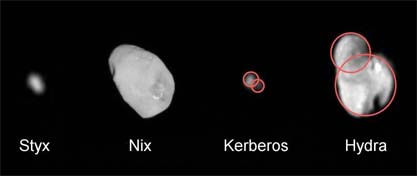
NASA / JHU-APL / SWRI
Mark Showalter (SETI Institute), who led the team that discovered Styx and Kerberos, thinks the moons' elongated shapes argue that they're clumps of smaller objects that merged at low speeds. In fact, he envisions that Pluto once had hundreds of small moons that eventually got swept up into Charon and its four smaller siblings. (That said, such a winnowing process should have driven many bodies into Pluto itself, and there's no evidence for enhanced cratering around Pluto's midsection.)
Typically small moons end up, thanks to strong tidal interactions, locked in spin rates that match their orbital periods. That's the norm in the satellite systems of Jupiter, Saturn, Uranus, and Neptune. But not so with Pluto's small moons! "Tidal locking isn't what's going on — we knew that," Showalter explains. "But we didn't anticipate what is going on."
All four appear to be spinning chaotically: Styx in 3.239 days, Nix in 1.829 days, Kerberos in 5.33 days, and Hydra in just 10.31 hours. All of these rates are much faster than the moons' orbital periods — in fact, Hydra spins around 89 times per 38-day-long orbit. Moreover, an analysis led by Simon Porter (Southwest Research Institute) shows that Nix is a retrograde rotator (its spin axis is tipped 132°) and that the spin axes of other three are tipped over sideways. "It's not just chaos but pandemonium," Showalter admits. "We've not seen anything like this before."
The animation below shows how fast these little moons spin compared to their orbital periods. (Pluto and Charon, colored tan, are locked in a 6.4-day-long embrace; here Styx is red, Nix is yellow, Kerberos is green, and Hydra is blue-violet.)
A Case for "Planethood"?
Given its amazing and unexpected geologic diversity, is Pluto a planet after all? "That's a question best addressed at a bar," Stern quipped when asked yesterday. But stay tuned — there'll be more to say about this divisive question later in the week.
Alan Stern offers his personal "Top Ten Surprises" from the New Horizons flyby in an exclusive blog for SkyandTelescope.com.
 8
8
Comments
Anthony Barreiro
November 10, 2015 at 4:28 pm
It is fascinating to be gradually discovering Pluto and Pluto's moons as the New Horizons scientists interpret the data streaming home from the spacecraft.
I would guess that Piccard Mons is named after Auguste Piccard (unless it's a misspelling of Jean Luc Picard). But there are an awful lot of Wrights. Which Wright is the right Wright for Wright Mons?
You must be logged in to post a comment.
Peter Wilson
November 12, 2015 at 9:57 am
The Isle of Wright.
You must be logged in to post a comment.
Anthony Barreiro
November 12, 2015 at 2:55 pm
Sorry, Isle of W(r)ight is the wrong answer.
You must be logged in to post a comment.
November 13, 2015 at 12:21 pm
One of the brothers Wright, unless that's the wrong Wright
You must be logged in to post a comment.
Jeff-Rabb
November 13, 2015 at 5:57 pm
I can't help wondering if when the scientist keep saying that tidal forces cannot be the answer to Pluto's inner heat because of tidal lock, that they are also factoring in the fact that Pluto and Charon orbit a point that is outside of Pluto's surface. In fact, when the Planetary Society posted a video composed of multiple images of the two taken when New Horizons was still a couple of months out, centered on that imaginary point, it really shows Pluto's wobble around that point. Maybe this is so counter-intuitive for me to grasp, but it really seems to me that there should be a lot of sloshing around of the interior of Pluto.
You must be logged in to post a comment.
Peter Wilson
November 15, 2015 at 10:06 am
The elliptical orbit may come to the rescue. As long as the distance between two bodies varies, there will be some tidal squeezing.
Of course, two wrongs don't make a right, but two Wrights made an airplane.
You must be logged in to post a comment.
Wayne-Wooten
November 12, 2015 at 5:26 pm
Back in 1995, my wife Merry Edenton-Wooten and I developed a planetarium show for Pensacola State College Foundation entitled "When Worlds Erupt". Her Enceladus oil painting was very prophetic, as noted by NASA in March 2006 when we got the first closeups from Cassini.
http://www.spaceweather.com/archive.php?day=10&month=03&year=2006&view=view&PHPSESSID=nt8mgul5lgvr5avdu6cg4bumm3
When we closed in on Pluto, her painting of possible eruptions on Pluto looked too blue and too new, but as we have gotten the latest NH images, perhaps she was quite prophetic at Pluto as well.
http://spaceweathergallery.com/indiv_upload.php?upload_id=115265&PHPSESSID=opv1n75ic4qltrdld3sv3dika1
You must be logged in to post a comment.
David Fried
November 13, 2015 at 5:07 pm
The volcanoes are certainly very surprising. Based upon elementary school science, is it possible that Pluto has large subsurface deposits of baking soda, activated by acid rain seeping through cracks in the surface?
You must be logged in to post a comment.
You must be logged in to post a comment.